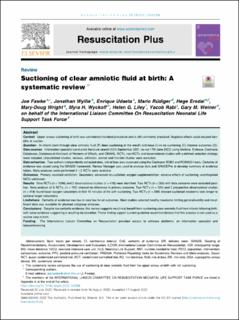| dc.contributor.author | Fawke, Joe | |
| dc.contributor.author | Wyllie, Jonathan | |
| dc.contributor.author | Udaeta, Enrique | |
| dc.contributor.author | Rüdiger, Mario | |
| dc.contributor.author | Ersdal, Hege Langli | |
| dc.contributor.author | Wright, Mary-Doug | |
| dc.contributor.author | Wyckoff, Myra H. | |
| dc.contributor.author | Liley, Helen G. | |
| dc.contributor.author | Rabi, Yacob | |
| dc.contributor.author | Weiner, Gary M. | |
| dc.date.accessioned | 2023-03-28T06:16:46Z | |
| dc.date.available | 2023-03-28T06:16:46Z | |
| dc.date.created | 2022-11-14T10:34:37Z | |
| dc.date.issued | 2022 | |
| dc.identifier.citation | Fawke, J., Wyllie, J., Udaeta, E., Rüdiger, M., Ersdal, H., Wright, M. D., ... & Force, L. S. T. (2022). Suctioning of clear amniotic fluid at birth: A systematic review. Resuscitation Plus, 12, 100298. | en_US |
| dc.identifier.issn | 2666-5204 | |
| dc.identifier.uri | https://hdl.handle.net/11250/3060624 | |
| dc.description.abstract | Context
Upper airway suctioning at birth was considered standard procedure and is still commonly practiced. Negative effects could exceed benefits of suction.
Question
In infants born through clear amniotic fluid (P) does suctioning of the mouth and nose (I) vs no suctioning (C) improve outcomes (O).
Data sources
Information specialist conducted literature search (12th September 2021, re-run 17th June 2022) using Medline, Embase, Cochrane Databases, Database of Abstracts of Reviews of Effects, and CINAHL. RCTs, non-RCTs and observational studies with a defined selection strategy were included. Unpublished studies, reviews, editorials, animal and manikin studies were excluded.
Data extraction
Two authors independently extracted data, risk of bias was assessed using the Cochrane ROB2 and ROBINS-I tools. Certainty of evidence was assed using the GRADE framework. Review Manager was used to analyse data and GRADEPro to develop summary of evidence tables. Meta-analyses were performed if ≥2 RCTs were available.
Outcomes
Primary: assisted ventilation. Secondary: advanced resuscitation, oxygen supplementation, adverse effects of suctioning, unanticipated NICU admission.
Results
Nine RCTs (n = 1096) and 2 observational studies (n = 418) were identified. Two RCTs (n = 280) with data concerns were excluded post-hoc. Meta-analysis of 3 RCTs, (n = 702) showed no difference in primary outcome. Two RCTs (n = 200) and 2 prospective observational studies (n = 418) found lower oxygen saturations in first 10 minutes of life with suctioning. Two RCTs (n = 200) showed suctioned newborns took longer to achieve target saturations.
Limitations
Certainty of evidence was low or very low for all outcomes. Most studies selected healthy newborns limiting generalisability and insufficient data was available for planned subgroup analyses.
Conclusions
Despite low certainty evidence, this review suggests no clinical benefit from suctioning clear amniotic fluid from infants following birth, with some evidence suggesting a resulting desaturation. These finding support current guideline recommendations that this practice is not used as a routine step in birth. | en_US |
| dc.language.iso | eng | en_US |
| dc.publisher | Elsevier | en_US |
| dc.rights | Navngivelse 4.0 Internasjonal | * |
| dc.rights.uri | http://creativecommons.org/licenses/by/4.0/deed.no | * |
| dc.title | Suctioning of clear amniotic fluid at birth: A systematic review | en_US |
| dc.type | Peer reviewed | en_US |
| dc.type | Journal article | en_US |
| dc.description.version | publishedVersion | en_US |
| dc.rights.holder | The authors | en_US |
| dc.subject.nsi | VDP::Medisinske Fag: 700 | en_US |
| dc.source.volume | 12 | en_US |
| dc.source.journal | Resuscitation Plus | en_US |
| dc.identifier.doi | 10.1016/j.resplu.2022.100298 | |
| dc.identifier.cristin | 2073317 | |
| cristin.ispublished | true | |
| cristin.fulltext | original | |
| cristin.qualitycode | 1 | |

